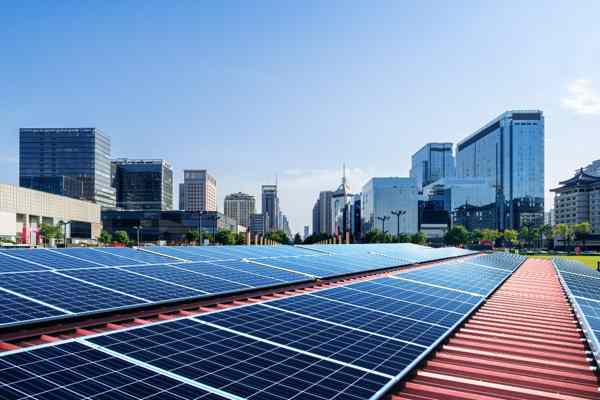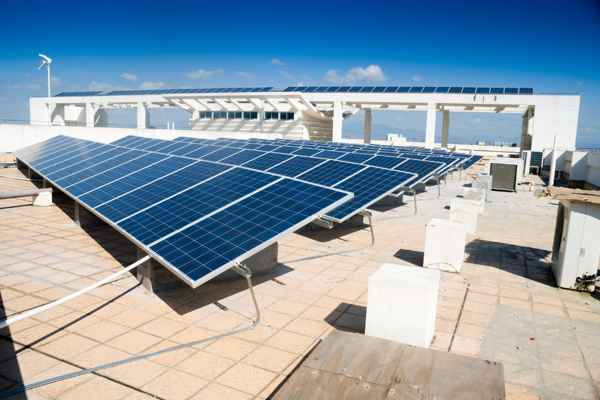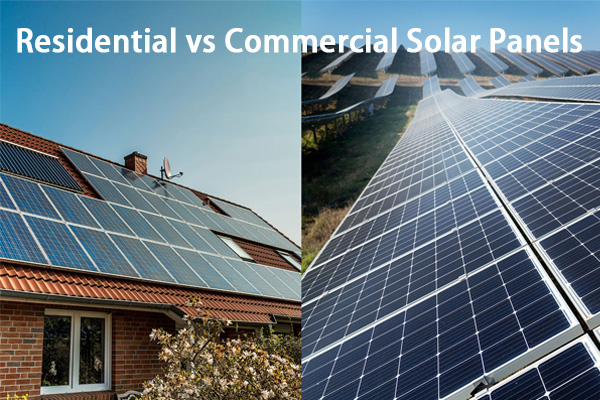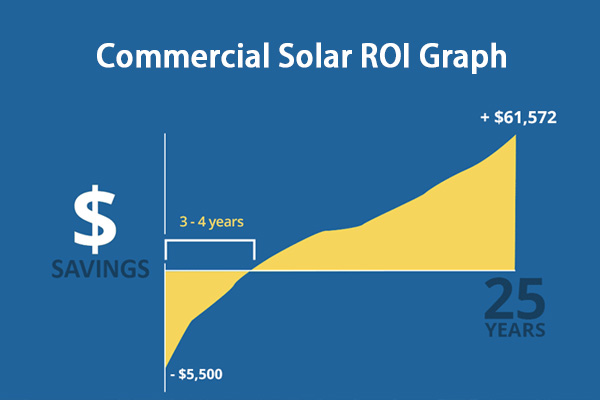Który rodzaj panelu słonecznego jest najlepszy do użytku komercyjnego?
Poruszanie się po świecie słonecznym dla Twojej firmy? Prawdopodobnie zastanawiasz się, który typ panelu naprawdę oferuje najlepszą wydajność i wartość dla operacji komercyjnych.
Kluczem jest zrozumienie, że „najlepsze" Wybór często sprowadza się do dopasowania właściwej technologii słonecznej do twoich unikalnych potrzeb energetycznych, dostępna przestrzeń, i cele finansowe.
Do zastosowań komercyjnych i przemysłowych, Decyzja zależy od czynników takich jak wydajność, trwałość, długoterminowa opłacalność (LCOE), oraz szczególne wymagania Twojego obiektu. Podczas gdy panele monokrystaliczne są często preferowane ze względu na ich wysoką wydajność i elegancki wygląd, Zwłaszcza tam, gdzie przestrzeń jest na premii, Panele polikrystaliczne historycznie oferowały bardziej przyjazny budżetowi koszt z góry, chociaż stają się coraz mniej powszechne (Sunsave, Energysage). Panele cienki, z ich elastycznością, może pasować do niszowych zastosowań lub bardzo dużych obszarów, w których niższa wydajność jest kompensowana według skali. W Gycx Solar, Pomagamy firmom przeciąć złożoność, aby znaleźć idealne rozwiązanie słoneczne.

Podróż do energii słonecznej dla Twojej firmy jest znacząca, A wybór odpowiednich paneli to krytyczny pierwszy krok.
Nie chodzi tylko o wytwarzanie energii elektrycznej; Chodzi o to, aby uzyskać rozsądną inwestycję finansową, osiągnięcie celów zrównoważonego rozwoju, i zapewnienie odporności energii przez wiele lat. Zbadamy najlepszych pretendentów i kluczowe rozważania, które pomogą Ci podjąć świadomą decyzję.
Jakie są najlepsze panele słoneczne do użytku komercyjnego?
Wskazanie „Najlepsze" Panele słoneczne dla Twojego budynku komercyjnego? Chcesz system, który nie tylko generuje maksymalną moc, ale także oferuje niezawodność i silny zwrot z inwestycji. Kilka kluczowych czynników łączy się, aby określić, co sprawia, że panel słoneczny jest optymalny dla wdrażania komercyjnego.
Ogólnie, Najlepsze panele słoneczne do użytku komercyjnego to te, które oferują doskonałą kombinację wysokiej wydajności, solidna trwałość, Kompleksowe gwarancje, i wsparcie z renomowanego, producent bankowy.
Panele monokrystaliczne1, często przekraczające 20% efektywność (Sunsave, Energysage), są popularnym wyborem, ponieważ maksymalizują produkcję energii w ograniczonych przestrzeniach, takie jak dachy. Kluczowi producenci często cytowani pod kątem jakości i wydajności w sektorze komercyjnym zawierają nazwy takie jak QCells, Jinko Solar, Trina Solar, Kanadyjski Solar, i grupa rec.
Marki te są uznawane za ich postęp technologiczny i zaangażowanie w długoterminową niezawodność.

Kiedy nurkujemy głębiej w wyborze najlepszych paneli słonecznych do użytku komercyjnego, Kilka krytycznych aspektów wchodzi poza tylko markę. W Gycx Solar, Prowadzimy naszych klientów przez kompleksową ocenę.
Efektywność jest najważniejsze; panele monokrystaliczne zwykle prowadzą, Przekształcanie większej ilości światła słonecznego w elektryczność na stopę kwadratową, co jest niezbędne dla firm o wysokich wymaganiach energii lub ograniczonej przestrzeni instalacyjnej.
Jednakże, Rozważamy również współczynnik temperatury, jako panele w gorętszych klimatach (Jak wiele części USA) może stracić wydajność wraz ze wzrostem temperatury - niższy współczynnik temperatury jest lepszy.
Trwałość i niezawodność nie są negocjacyjne dla długoterminowego aktywów. Panele komercyjne muszą wytrzymać dziesięciolecia pogody, Więc szukamy solidnej budowy, Oceny silnego wiatru i śniegu, i kompleksowe gwarancje, zazwyczaj 25-letnie gwarancje wyników i 12 do 25-letnich gwarancji produktu. Niektóre marki premium, takie jak Maxeon, oferują nawet 40-letnie gwarancje (Energysage).
The Bankowalność producenta -Ich zdrowie finansowe i prawdopodobieństwo uhonorowania długoterminowych gwarancji-jest również kluczowym czynnikiem dla projektów komercyjnych, które reprezentują znaczące inwestycje.
Analizujemy również określone warunki witryny, takie jak typ dachu (płaski, rozbity), Potencjał systemów montowanych na ziemi, oraz lokalne wzorce klimatyczne w celu zapewnienia, że wybrana technologia panelu zapewni optymalną produkcję energii dożywotniej i najlepiej wyrównany koszt energii (LCOE).
Który panel słoneczny jest najlepszy do użytku przemysłowego?
Zasilanie dużego obiektu przemysłowego ze swoim znaczącym apetytem na energię? Potrzebujesz paneli słonecznych zaprojektowanych do wdrożenia na dużą skalę, zdolne do wytrzymania potencjalnie wymagających warunków, i dostarczanie maksymalnej wydajności. Przemysłowe zastosowania słoneczne często mają unikalne wymagania, które wpływają na wybór panelu.
Do użytku przemysłowego, Preferowana opcja jest ogólnie preferowana opcja, zwłaszcza gdy dąży do maksymalizacji wytwarzania energii na ekspansywnych dachach fabrycznych lub w dużych podstawowych tablicach.
Ich zdolność do wytwarzania większej mocy na jednostkę obszaru pomaga zoptymalizować zużycie powierzchni ziemi lub dachu.
Ponadto, Trwałość jest najważniejsza w ustawieniach przemysłowych, które czasami mogą narażać panele na więcej pyłu, wibracje, lub określone emisje.
Dwufasowe panele słoneczne, które może uchwycić światło słoneczne zarówno z przednich, jak i tylnych powierzchni, wykorzystując odbite światło (Albedo), stają się również doskonałym wyborem dla montowanych na ziemi systemów przemysłowych, potencjalnie zwiększając wydajność energii przez 30% W optymalnych warunkach.

Projekty słoneczne w skali przemysłowej wymagają strategicznego podejścia do wyboru panelu, Koncentrując się na długoterminowej wydajności i wydajności energii. W Gycx Solar, Kiedy oceniamy rozwiązania dla klientów przemysłowych, Maksymalizacja kilowatogodzin (kWh) wyjście jest często głównym kierowcą.
To naturalnie prowadzi do preferencji dla wysokowydajnych paneli monokrystalicznych, w tym zaawansowane technologie, takie jak heterOjunction (HJT) lub komórki topcon, które zwiększają wydajność jeszcze wyższą (JMS Energy, Epl). Dla systemów montowanych na ziemi, które są powszechne w warunkach przemysłowych z dostępnymi ziemią, Panele dwufasowe oferować znaczącą przewagę, przechwytując odbite światło słoneczne, W ten sposób zwiększając ogólne zbiory energii bez konieczności dodatkowej przestrzeni.
Wybór konstrukcji montażowych-stałych przechyleń lub śledzer. Solidność i trwałość są krytyczne; Panele muszą przetrwać 25-30+ lata, Często w środowiskach z większą liczbą cząstek cząstek lub potencjału na ekstremalną pogodę.
Szukamy paneli z silnymi certyfikatami przeciwko PID (Potencjalna degradacja indukowana), POKRYWA (Degradacja wywołana światłem), mgła solna, i korozja amoniaku, w zależności od strony.
The Wyrównany koszt energii (LCOE) staje się kluczową miarą, i podczas gdy panele o wysokiej wydajności mogą mieć wyższy koszt z góry na panel, Ich zwiększona produkcja energii w ciągu życia systemu często powoduje niższe LCOE dla dużych instalacji przemysłowych (Magazyn PV, Tech PV).
Czy istnieje różnica między mieszkalnymi i komercyjnymi paneli słonecznych?
Być może zastanawiasz się, czy panele słoneczne zdobiące duży magazyn są takie same jak te w domu podmiejskim. Podczas gdy fundamentalna technologia fotowoltaiczna jest podobna, Istnieją rzeczywiście kluczowe różnice między paneli słonecznych mieszkalnych i komercyjnych, napędzany skalą, aplikacja, i środowiska regulacyjne.
Tak, Istnieją wyraźne różnice. Komercyjne panele słoneczne są często fizycznie większe (NP., używając 72, 96, lub nawet więcej komórek w porównaniu do wspólnych 60 lub 72-komórkowe panele mieszkalne) i może pochwalić się wyższymi indywidualnymi ocenami masy w celu zoptymalizowania instalacji na dużą skalę poprzez zmniejszenie liczby potrzebnych paneli i połączeń.
Komercyjne systemy słoneczne zwykle działają również przy znacznie wyższych napięciach DC (NP., 1000V lub 1500 V w porównaniu do 600 V dla systemów mieszkalnych) Aby poprawić wydajność w dłuższych przebieżach kablowych i zmniejszyć koszty salda systemu (Solarsupersonic).
Ponadto, Systemy montażowe do instalacji komercyjnych, szczególnie na dużych płaskich dachach (Systemy balastowane) lub mocowania naziemne, są inaczej inaczej i są często bardziej solidne i złożone niż typowe instalacje na dach mieszkalnych.

Zagłębianie się głębiej, Rozróżnienia między mieszkalnymi i komercyjnymi paneli słonecznych wykraczają poza tylko rozmiar fizyczny i napięcie.
Skala projektu i złożoność są zupełnie inne. Komercyjne projekty słoneczne obejmują bardziej skomplikowane względy projektowe, takie jak analiza obciążenia strukturalnego na dużych dachach, Rozległe okablowanie dla rozległych tablic, oraz wyrafinowane badania połączeń z siecią użytkową.
The Procesy zezwolenia i inspekcji są również ogólnie bardziej zaangażowane w systemy komercyjne ze względu na ich wielkość i wpływ publiczny. Mechanizmy finansowania również się rozbiega; podczas gdy właściciele domów mogą korzystać z pożyczek lub umowy najmu, Projekty komercyjne często wykorzystują umowy zakupowe zasilania (umowy PPA), Leasing operacyjny, lub bezpośrednia własność w połączeniu z konkretnymi zaletami podatku od działalności gospodarczej, takimi jak amortyzacja MACRS (Paradise Energy Solutions, Green Ridge Solar).
Nawet rodzaje falowników używane może się różnić; podczas gdy falowniki strunowe są powszechne w obu, Większe projekty komercyjne mogą korzystać z centralnych falowników o dużej pojemności, lub coraz częściej, Architektury rozproszone z wieloma falownikami strunowymi w celu lepszej tolerancji błędów i optymalizacji.
Podczas gdy podstawowe komórki fotowoltaiczne (monokrystaliczny, polikrystaliczny) Udostępnij tę samą technologię na bazie krzemu, Ogólna budowa panelu, ramy, a konstrukcja skrzyżowania połączeń może być dostosowana do określonych rygorów i metod instalacji środowisk komercyjnych.
W Gycx Solar, Codziennie poruszamy te różnice, Zapewnienie każdego elementu, od panelu do falownika i stojaka, doskonale nadaje się do skali i specyficznych potrzeb operacyjnych naszych klientów komercyjnych.
Czy panele słoneczne są tego warte dla budynków komercyjnych?
Rozważanie znacznej inwestycji, takiej jak Solar dla Twojej nieruchomości komercyjnej? Prawdopodobnie rozważasz koszty w stosunku do korzyści i zadasz kluczowe pytanie: Czy panele słoneczne są naprawdę wartościowe przedsięwzięcia dla firm? Dla zdecydowanej większości budynków komercyjnych, Odpowiedź jest stanowczy „Tak."
Absolutnie! Inwestowanie w panele słoneczne dla budynków komercyjnych zazwyczaj oferuje przekonujący przypadek finansowy i operacyjny. Najbardziej bezpośrednia korzyść jest znacząca Zmniejszenie rachunków za energię elektryczną, które mogą znacznie obniżyć koszty operacyjne i poprawić wyniki finansowe.
Komercyjne instalacje słoneczne często zapewniają atrakcyjne Zwroty z inwestycji (Zwrot z inwestycji), z okresami zwrotu, które mogą obejmować 5 Do 10 lata, Czasami nawet mniej, zwłaszcza przy uwzględnieniu zachęt (Paradise Energy Solutions). Poza bezpośrednimi oszczędnościami, Oferty słoneczne pewność budżetu przez zabezpieczenie się przed niestabilnymi i często podnoszącymi ceny energii elektrycznej.
Ponadto, Przyjęcie słonecznych poprawia Twoją firmę Obraz marki, Wykazanie zaangażowania w zrównoważony rozwój i środowisko, Społeczny, i zarządzanie (Esg) zasady, co jest coraz ważniejsze dla klientów, pracownicy, i inwestorzy (Cedar Creek Energy).
Krytycznie, firmy w USA. może wykorzystać znaczące zachęty finansowe, takie jak federalna ulga podatkowa inwestycyjna (ITC), które mogą obejmować 30% lub więcej kosztów systemu, i przyspieszona amortyzacja (Macrs), Dalsze osłodzenie doniczki finansowej (Paradise Energy Solutions, Green Ridge Solar).

Propozycja wartości komercyjnej słonecznej wykracza daleko poza tylko niższe rachunki za energię. Kiedy w Gycx Solar analizujemy wykonalność dla firm, Patrzymy na kompleksowy obraz. The Wyrównany koszt energii (LCOE) z układu słonecznego jest często znacznie niższe niż zakup energii elektrycznej w stosunku do 25-30+ rok życia paneli, Zapewnienie długoterminowej przewagi konkurencyjnej (Magazyn PV).
The Federalna ulga podatkowa na inwestycje słoneczne (ITC), obecnie u podstawy 30% i potencjalnie wyższe z dodatkami do treści krajowych, społeczności energetyczne, lub obszary o niskich dochodach, drastycznie zmniejsza początkowe nakłady (Paradise Energy Solutions).
W połączeniu z Zmodyfikowany przyspieszony system odzyskiwania kosztów (Macrs), co pozwala firmom szybkie amortyzowanie dużej części wartości zasobu słonecznego (40% dodatkowa amortyzacja w 2025 dla podstawowej podstawy, co jest 85% systemu kosztuje, jeśli 30% ITC jest zajęte), Dyskusje podatkowe są znaczne (Green Ridge Solar). Ponadto, Solar pozytywnie przyczynia się do firmy Esg (Środowiskowy, Społeczny, i zarządzanie) profil, co jest coraz bardziej czynnikiem w decyzjach inwestycyjnych, Lojalność klientów, i atrakcja pracowników.
To namacalnie zmniejsza ślad węglowy firmy i prezentuje zaangażowanie w zrównoważone praktyki. Niektóre regiony oferują również kredyty energii odnawialnej słonecznej (Srecs) lub inne lokalne zachęty, Tworzenie dodatkowych strumieni lub oszczędności. Ostatecznie, Commercial Solar to strategiczna inwestycja, która wypłaca dywidendy finansowe, środowisko, i reputacyjnie.
Wybór odpowiednich paneli słonecznych jest kluczowy dla maksymalizacji korzyści z komercyjnego projektu słonecznego.
Czy priorytetowo traktuje najwyższą wydajność paneli monokrystalicznych dla ograniczonej przestrzeni, potencjalny wzrost wydajności z paneli dwufasowych dla przemysłowych montoków naziemnych, lub zrozumienie niuansów, które odróżniają systemy komercyjne od mieszkalnych, Podjęcie świadomej decyzji jest kluczowe.
Dowody silnie potwierdzają, że panele słoneczne są dźwiękiem, opłacalny, oraz zrównoważone inwestycje w większości budynków komercyjnych i przemysłowych.
Na Gycx Solar, Specjalizujemy się w pomaganiu firmom takim jak twoje w nawigacji w tych wyborach. Zapewniamy dostosowane oceny i rozwiązania, Wykorzystanie naszej wiedzy specjalistycznej do projektowania i instalowania komercyjnych systemów słonecznych, które zapewniają trwałą wartość.
Jeśli jesteś gotowy zbadać, w jaki sposób Solar może przekształcić strategię energetyczną i wynikającą linię firmy, Zachęcamy do skontaktowania się z nami na konsultację.
Dowiedz się o monokrystalicznych panelach krzemowych, aby uzyskać lepsze informacje porównawcze panelu słonecznego. Aby pomóc Ci wybrać produkt, który lepiej odpowiada Twoim potrzebom. ↩
